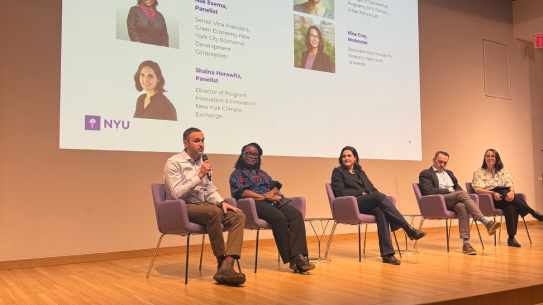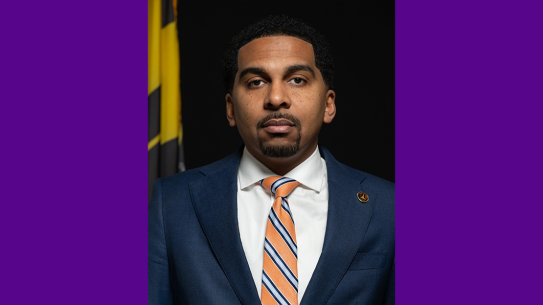NYU Tandon welcomes new faculty members with an environmental focus

Bridger Ruyle (left); Anamika Shreevastava (right)
With dire threats being posed by pollution and climate change, engineering holds the key to a greener, healthier future. Our new assistant professors are helping turn that key.
New Faculty:
Bridger Ruyle
Assistant Professor of Civil and Urban Engineering
When Bridger Ruyle was an undergraduate studying environmental engineering at the University of Colorado, Boulder, it was the height of the fracking boom, and he became involved in a research project that sought to determine how wastewater from the extraction of shale gas and oil affected downstream communities. The issue was personal for him: his grandparents lived in one of those communities. Although part of the impetus for choosing his major was that in the years following the great recession of 2008, engineering seemed like a solid career path, he now realized that it would also allow him to make a positive impact in areas that were truly important to him.
As he neared graduation, he was introduced to a topic that would deeply influence his academic path and research career. A good friend who lived near Fort Carson recounted an incident in which military officials came to their home to test their well water for two chemicals they had never heard of: PFOS and PFOA.
As it turns out, the firefighting foams used at military bases to conduct tests and trainings contained high levels of PFOS, PFOA, and other per- and polyfluoroalkyl substances (PFAS), commonly called “forever chemicals” because they do not readily break down in the environment or in the human body. After their use for firefighting training and in other applications such as non-stick cookware and plastics manufacturing, PFAS migrate into soils and water where they can contaminate water resources. To protect public health against the threats of PFAS pollution, the U.S. Environmental Protection Agency (EPA) established drinking water regulations for PFOS, PFOA, and four other PFAS in 2024.
What happens to PFAS in the environment became the basis for his graduate research at Harvard, where in 2022 he earned both an M.S. in applied mathematics and a Ph.D. in environmental science and engineering.
At Tandon, his research will focus on forever chemicals and other highly fluorinated chemicals whose implications for public health are not yet known — vital work considering that according to a study he recently conducted of wastewater treatment plants, the six forever chemicals now regulated by the EPA in drinking water make up only about 8% of the organic fluorine found in effluent. “There are virtually no natural analogs,” he says. “As a society, we now rely upon an entirely new class of chemistry that has never existed before in the history of Earth that we don’t know enough about.”
He will also be studying the impacts of climate change on forever chemicals and other important global water quality issues such as nitrogen pollution. Scientists know that droughts and floods are increasing in frequency and intensity, but water quantity goes hand-in-hand with water quality, he explains, saying, “What good is a lot of water if it’s not usable.”
He will be teaching a graduate course in environmental chemistry and microbiology this fall and also hopes to develop one focused on biogeochemistry, the study of the chemical, physical, geological, and biological processes that govern the composition and evolution of Earth. “Studying natural Earth processes can inform sustainable engineering practices of the future,” he asserts.
Anamika Shreevastava
Assistant Professor in the Department of Mechanical and Aerospace Engineering and at the Center for Urban Science & Progress (CUSP)
Over the years, Anamika Shreevastava’s view of her work has expanded — from building scale to city scale, and, ultimately, encompassing the entire planet.
Shreevastava received her bachelor's degree from the Indian Institute of Technology and then embarked on a master’s program in architectural engineering at Purdue University, where she studied ways to make the heating and cooling systems of buildings more energy efficient. But individual buildings can’t be considered in a vacuum, she quickly discovered. “When you cool down a building, the heat has to go somewhere, and it simply goes out into the environment! In other words, the city itself became a dumping ground for heat,” she explains. It was this realization that prompted a significant shift, and her ambition evolved beyond cooling buildings to the city itself.
She ultimately expanded upon the traditional notion of the urban heat island — a phenomenon where cities are significantly warmer than their surroundings — and introduced the concept of “fractal intra-urban heat islets,” which factors in how urban heat is distributed and layered within cities and identifies regularities and common patterns in places where these hot spots routinely emerge.
Her studies led to another realization: urban heat is not just an atmospheric problem to solve; it is a socioeconomic one since it disproportionately affects financially disadvantaged populations within the urban ecosystem. This solidified her resolve to pursue her doctoral degree in ecological sciences and engineering at Purdue. “My doctoral advisor, Suresh Rao, put it to me this way,” she recalls. “There’s no use studying only the ‘dead’ parts of the city; you’ve got to consider the living too!” Viewing the city as a living, breathing organism, Shreevastava understood that its human residents and workers were central to its vitality.
“In a heat wave, not everyone suffers equally, and this goes well beyond simply affording air conditioning,” she says. “Sometimes, because of systematic injustice in urban infrastructure development, which kept members of certain ethnic and racial groups out of desirable neighborhoods by denying them mortgages and leases, many people ended up in areas with a lack of trees and parks, which makes it harder to stay cool. ” Additionally, she noted, significant differences exist in how people become acclimatized to extreme heat in various parts of the world; in her native India, for example, temperatures routinely hit 90 degrees Fahrenheit without triggering a heatwave warning.
While at Purdue, Shreevastava had been a NASA Earth and Space Science Fellow, and once she earned her Ph.D., she joined the agency’s Jet Propulsion Lab (JPL) and CalTech as a NASA Postdoctoral Fellow, a post that enabled her to look at things not just at city scale, but at planet scale. There she studied how urban activity across the world has had an impact on the Earth’s biosphere and leveraged advanced thermal remote sensing and urban microclimate monitoring to help find novel ways of cooling urban neighborhoods.
She is looking forward to her arrival in Brooklyn this fall. “Extreme weather and urban socio-physical systems are two interconnected, dynamic systems,” she says, “so it’s great to be affiliated with a truly interdisciplinary place like CUSP, which is dedicated to studying every aspect of urban complexity”. Besides the chance to work at CUSP, she is excited to be a part of the especially vibrant and dynamic New York City and study, as she says, “the urban marvel from within.”




